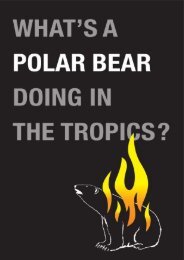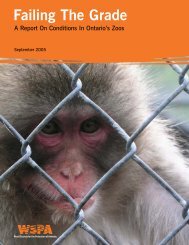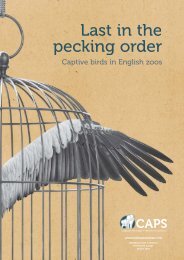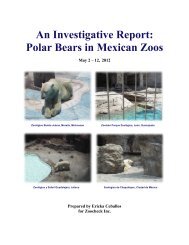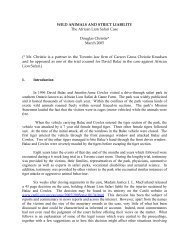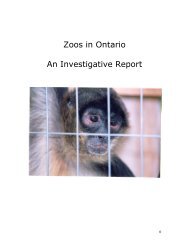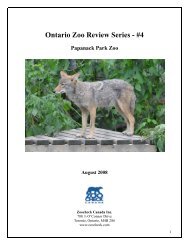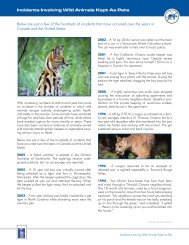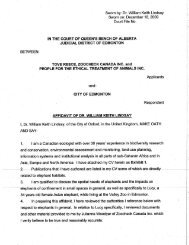Ontario Zoo Review Series - #6 - Zoocheck Canada
Ontario Zoo Review Series - #6 - Zoocheck Canada
Ontario Zoo Review Series - #6 - Zoocheck Canada
Create successful ePaper yourself
Turn your PDF publications into a flip-book with our unique Google optimized e-Paper software.
male. The female bear waved her paw at the zookeeper to get her food; it appeared as though she had been<br />
trained to perform this trick.<br />
After the feeding, the zookeeper stayed to answer questions. He said:<br />
• They do not clean up in the enclosures as they believe in the “natural” way of “self cleaning enclosures”<br />
[decomposition] indicating that they have earth substrates.<br />
Since animal territories in the wild are much larger than zoo enclosures, the animals do not typically contact<br />
their own waste. In zoo enclosures, which are orders of magnitude smaller than home ranges in the wild, animals<br />
do contact their own waste. Therefore, feces should be cleaned out periodically. This does not seem to be the<br />
case at Northwoods.<br />
• Animals are fed once a day in single-piled feedings or their food is thrown over the barrier. The zoo<br />
keeper told the crowd that the brown bears are not fed everyday and to “accommodate” denning they<br />
withdraw food on Dec 1 st and do not fed them again until the end of March.<br />
Modern facilities accommodate denning by gradually reducing the quantity of food to stimulate or coincide with<br />
the natural tendency of the bears to lose their appetites as winter approaches. A sudden stoppage of feeding at an<br />
arbitrary point is an outdated husbandry method.<br />
The brown bears are fed together during a public program where the zookeeper throws meat over the fence. The<br />
bears fight for position and are clearly stressed, anxious and in direct competition for food.<br />
While observing this feeding one bear bit another in the left rear flank. I saw a substantial raw, red, superficial<br />
wound on the second bear after the feeding, but I was unable to photograph it. The zookeeper was there but did<br />
not seem to notice the attack.<br />
According to gift store staff, animals are bred and some are removed from their mothers to be hand-raised and<br />
then trained for Predator Productions. They indicated that the three tiger cubs that visitors are able to play with<br />
through the fence were removed for that purpose.<br />
There are a minimum of 12 lions in various enclosures, housed in various groupings or singly. One group is a<br />
“pride” consisting of one male, two adult females (mother and daughter), and three cubs. Gift shop staff said<br />
their breeding was accidental. Lions are social animals that should be kept in a natural social context. Since they<br />
are already in a surplus situation in captivity, they should not be allowed to breed.<br />
Several primate species, including vervet monkeys, lion-tailed macaques, Celebes crested macaques, and whitehanded<br />
gibbons, were housed in rudimentary, relatively barren cages with minimal perching, where I observed<br />
them sitting or lying. Some were inappropriately housed alone, while others were in pairs or small groups.<br />
Northwoods also houses wildlife species native to <strong>Ontario</strong>, including an American black bear, cougar, bobcat,<br />
lynx, fox and wolves. They are licensed by the <strong>Ontario</strong> Ministry of Natural Resources (OMNR) as a zoo. The<br />
OMNR should require this facility to improve the level of stimulation provided to these animals, particularly<br />
through various modes of environmental enrichment.<br />
In general, the animals had nothing to do, so they did nothing except recline and stare out of their cages. I did<br />
observe several animals pacing and many of the enclosures had grooved, well worn pacing paths along their<br />
interior fence lines. This is typically a sign of animals that are bored and/or frustrated.<br />
Northwoods also advertises its role in the European Snow leopard and Amur leopard SSP (Species Survival<br />
Plan). The SSP however is an American-based program, while endangered species breeding programs in Europe<br />
are known as EEPs. Regardless, the keeping of single individuals in old-style, raised, cement floored cages that<br />
6



